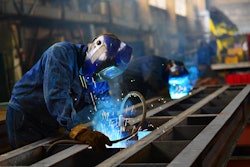Food and beverage process filtration is crucial for protecting consumers from contaminants including dust, bacteria and parasites. Under production demands in today’s plants, better performance is required from sterile gas and liquid filters. Yet the technology has not appreciably changed in three decades.
Over the past two years though, a team of 40 materials scientists and engineers teamed up with Coca-Cola, Nestlé, Danoné, Molson Coors-Romania and other food and beverage companies to address three long-standing challenges in microfiltration. They relate to:
- Throughput volume
- Integrity and lifecycle
- Filter replacement
The collaboration between users and manufacturers has produced a new generation of filter elements introduced into Europe and North America last year. The elements aim to enhance performance in the following ways:
Throughput Volume
To speed up production, sterile-grade process filters need to handle a higher volume flow rate. Flow performance is driven primarily by volume of media in the cartridge — the most restrictive area in the element. That’s where improvements have historically run into limitations.
Elements need to remain about 2.75” diameter, with lengths in 10” increments — the industry’s established cartridge size. Within this standard, attempts to modify the internal filter media have involved trade-offs between volume of flow and higher pressure drops, which consume additional energy.
To solve this challenge, engineers developed a pleat pack with a dense configuration of polyethersulfone (PES) media. PES membrane is effective in sterilizing liquids because its assymetrical “pores” are graduated in diameter. They taper to a microscopic size at the clean side, providing the cut-off range necessary for sterilization, while improving flow capacity compared with a symmetric membrane.
By packing a standard-size cartridge with 20 percent more of this material — and increasing the cartridge’s “free space” to optimize flow — the new element is capable of processing up to 20 percent more fluid without increasing assembly size or pumping pressure. In most applications, production increases and energy use decreases. Hardware such as filter housings can stay intact since the element works in most manufacturers’ vessels.
Integrity and Lifecycle
The harsh conditions of processing, cleaning and sterilization in food and beverage plants wear out filters quickly, not to mention posing a risk of integrity failure. A process filter must withstand one kind of force during installation and removal, and another during operation.
The filter is only as effective as its supporting structure. When maintenance staff install or remove a cartridge with locking tabs (present in the most popular connection styles), they often need to apply a strong torque to get tabs to lock in place — especially if they don’t pre-lubricate the O-rings due to time constraints.
This matters because filter media is a delicate, precision structure. Any cage twisting can potentially cause the sensitive media to yield or permanently change shape, especially in inelastic materials like PTFE membrane.
So cage strength was a key goal in the engineering project. New filter elements are structured around diamond shapes or triangulations — the same concept use to support bridges and building trusses. A rigid cage helps resist forces that can break or weaken the element.
This design better withstands the second force as well: pressure differential across the filter during high volumes of fluid processing every day. It’s crucial the element resists collapse — a greater risk in food and beverage plants processing highly viscous fluids or doing steam sterilization, which tends to soften filter cages. While sterilization does not require flow of steam, in many cases a plant’s system design forces steam through the filter. A filter that withstands compromise during installation and operation improves safety, lifecycle, and overall cost savings.
Filter Replacement
The third challenge for liquid and gas filtration has been a supply chain issue. Rapid part replacement minimizes downtime. Yet processing applications vary so widely that suppliers have proliferated thousands of unique parts in various lengths, media, micron ratings, elastomer types and end connections. Components often have to be batch-manufactured in larger volumes, creating wait times for a specific component.
To address this problem, engineers on the new filter technology developed single-flow manufacturing. This minimizes changes to the production line required to make variations. Components in each 10” element module — including a specific length or end-cap style — can be quickly custom-manufactured even one at a time with a choice of media. Each part is integrity-tested before shipping, and has full traceability with individual serial numbers, not lot numbers.
Common in other industries, this lean manufacturing system also reduces inventory to count, move, store, and pick, which cuts lead time between order and delivery — and potentially reduces manufacturer defects as well.
Putting the Benefits Together
After a long plateau in food and beverage filtration technology, processors have made their needs clear — and a manufacturing team has responded with a redesign that improves throughput, life cycle, and supply issues. The first elements developed around these principles are the LifeTec filtration line made by Donaldson Company. Coca-Cola plants in Europe and others who participated in the product development are now the first customers. When food and beverage processors evaluate their sterile filtration systems, the new technology may provide an opportunity to bolster operational performance and safety confidence.
About the author
Colter Marcks is a Lead Development Engineer in Donaldson Company’s Process Filtration Division. His filtration product development experience is focused on technologies, applications, and regulations related to liquid filtration, culinary steam, and sterile air production in the food and beverage industry.





















